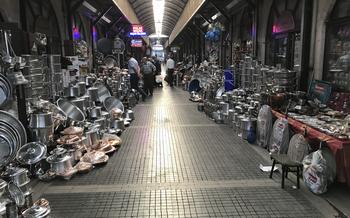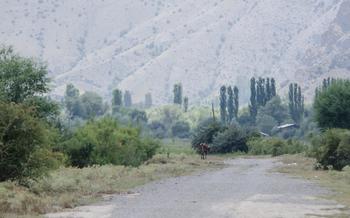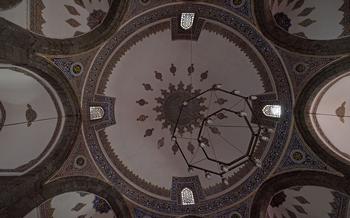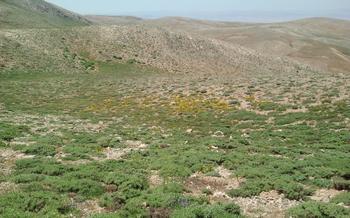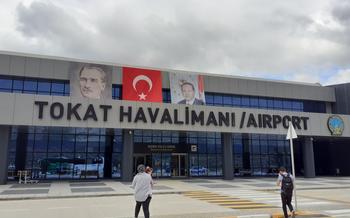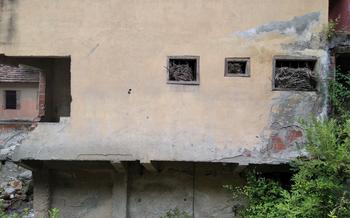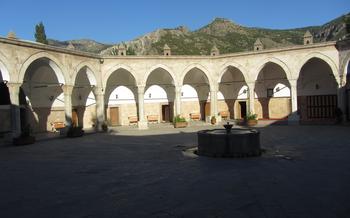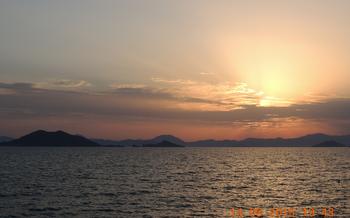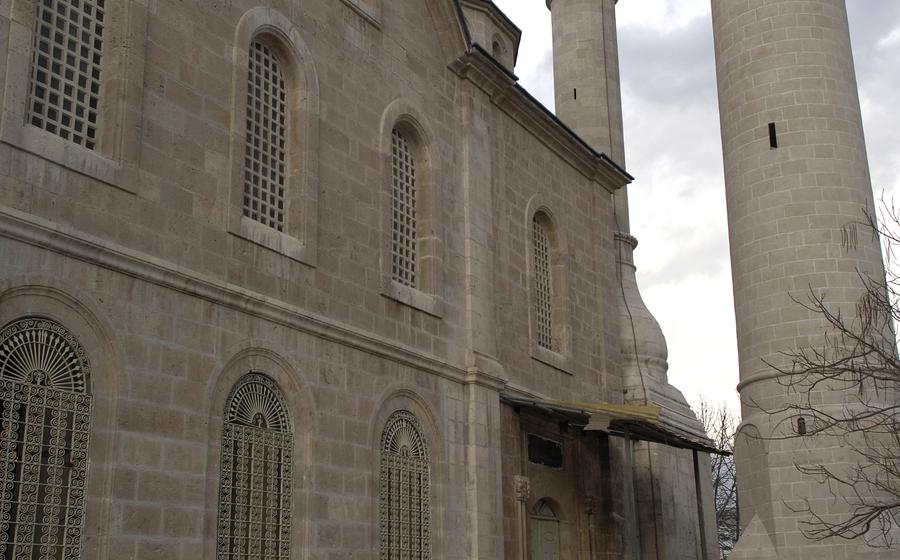
Yeni Mosque (Yeni Cami)
- Yeni Mosque (Yeni Cami): An Architectural Masterpiece
- The Grand Courtyard: A Place of Tranquility
- The Prayer Hall: A Showcase of Islamic Art
- The Minaret: A Symbol of Divine Presence
- The History of Yeni Mosque: A Journey Through Time
- Visiting Yeni Mosque: Practical Information
- The Yeni Mosque Complex: A Hub of Activity
- The Surroundings of Yeni Mosque: Exploring Malatya
- The Symbolism of Yeni Mosque: A Reflection of Faith
- The Yeni Mosque and the Ottoman Empire: A Legacy of Grandeur
- The Yeni Mosque Today: A Living Legacy
- The Yeni Mosque: A Bridge Between Past and Present
- The Yeni Mosque in Literature and Art: A Source of Inspiration
- The Yeni Mosque and Local Traditions: A Reflection of Community
- Insider Tip: Capture the Essence of Yeni Mosque
Yeni Mosque (Yeni Cami): An Architectural Masterpiece
The Yeni Mosque, also known as the Ulu Cami, stands as a testament to the architectural brilliance of the Ottoman Empire. Built in the 16th century during the reign of Sultan Suleiman the Magnificent, this awe-inspiring edifice reflects the grandeur and opulence of the era. Located in the heart of Malatya, Turkey, the mosque remains a prominent landmark and a source of pride for the city.
Historical Significance: The Yeni Mosque holds immense historical significance as a symbol of Ottoman architectural prowess. Its construction marked a turning point in Malatya's urban development, transforming the city into a significant center of commerce and culture. The mosque's enduring presence has witnessed numerous historical events, serving as a gathering place for the community and a venue for religious ceremonies and celebrations.
Architectural Features: The Yeni Mosque showcases an exquisite blend of classical Ottoman and Seljuk architectural styles. Its imposing structure features a grand central dome, supported by four massive pillars. The exterior facade is adorned with intricate stone carvings, geometric patterns, and vibrant tilework, reflecting the artistic mastery of the period. The mosque's interior is equally captivating, with a spacious prayer hall adorned with stunning calligraphy, intricate mihrabs, and a mesmerizing chandelier.
Location and Accessibility: The Yeni Mosque is strategically located in the heart of Malatya, on Cumhuriyet Meydanı, making it easily accessible to visitors. The mosque's proximity to other historical landmarks, such as the Malatya Museum and the old city center, allows for a convenient exploration of the city's rich cultural heritage.
The Grand Courtyard: A Place of Tranquility
The Yeni Mosque's grand courtyard is a serene oasis, inviting visitors to pause and reflect. Surrounded by elegant arches and intricate tilework, the courtyard exudes a sense of peace and tranquility. Its spacious layout and open design create a welcoming atmosphere, encouraging contemplation and spiritual reflection.
The courtyard is adorned with stunning Islamic art and symbolism, showcasing the mosque's rich cultural heritage. Geometric patterns, floral motifs, and calligraphy verses from the Quran grace the walls, creating a visually captivating display. The harmonious blend of colors and intricate designs evokes a sense of awe and wonder, inviting visitors to appreciate the craftsmanship and artistry that went into its creation.
Beyond its aesthetic beauty, the courtyard serves as a functional space for ablution and purification rituals before prayer. Water fountains and ablution facilities are conveniently located, allowing worshippers to prepare themselves for their spiritual journey. The courtyard's serene ambiance and tranquil atmosphere contribute to the overall experience of spiritual cleansing and renewal.
The Prayer Hall: A Showcase of Islamic Art
The prayer hall of the Yeni Mosque is a breathtaking masterpiece of Islamic architecture and design. Its spacious interior is adorned with intricate designs, calligraphy, and colorful tiles that create a truly awe-inspiring ambiance. The walls are adorned with verses from the Quran, beautifully inscribed in elegant Arabic calligraphy. The mihrab, or prayer niche, is the focal point of the hall, intricately carved with geometric patterns and Quranic verses. The pulpit, or minbar, where the imam delivers the sermon, is an exquisite piece of craftsmanship, adorned with intricate carvings and inlaid with mother-of-pearl.
The ceiling of the prayer hall is a marvel of engineering and artistry. It is decorated with a series of domes, each adorned with colorful tiles and intricate patterns. The central dome is the largest and most elaborate, featuring a stunning depiction of the heavens, with stars and constellations shining brightly against a deep blue background. The overall effect is one of grandeur and opulence, creating a space that is both awe-inspiring and conducive to prayer and contemplation.
The Minaret: A Symbol of Divine Presence
The Yeni Mosque's minaret stands tall and proud, piercing the sky like a celestial beacon. Its slender cylindrical form, adorned with intricate carvings and patterns, reflects the mosque's architectural grandeur. As a symbol of divine presence, the minaret serves as a physical representation of the connection between heaven and earth. It is from this elevated platform that the muezzin's call to prayer echoes throughout the city, summoning the faithful to come together and worship.
The minaret's design is both functional and symbolic. Its height allows the muezzin's voice to carry far and wide, ensuring that the call to prayer reaches every corner of the city. At the same time, the minaret's intricate ornamentation reflects the mosque's commitment to Islamic art and aesthetics. The interplay of geometric patterns and calligraphy creates a mesmerizing visual effect that draws the eye upward, symbolizing the believer's aspiration to connect with the divine.
Climbing the spiral staircase to the top of the minaret is an unforgettable experience. With each step, visitors are rewarded with breathtaking views of the surrounding city. The city's rooftops, domes, and spires stretch out in all directions, creating a panorama of architectural wonders. In the distance, the snow-capped peaks of the Taurus Mountains rise majestically, providing a stunning backdrop to the urban landscape. From this elevated vantage point, visitors can truly appreciate the scale and grandeur of the Yeni Mosque and its place within the city's skyline.
The History of Yeni Mosque: A Journey Through Time
The Yeni Mosque in Malatya, Turkey, holds a remarkable history that spans several centuries. Its construction began in the mid-16th century during the reign of Ottoman Sultan Suleiman the Magnificent, a period marked by architectural and cultural flourishing. The mosque was commissioned by the Grand Vizier of the time, Sokollu Mehmet Pasha, as a testament to his devotion and loyalty to the sultan.
Built on the foundations of an earlier Byzantine church, the Yeni Mosque reflects the fusion of architectural influences prevalent in the region. It took several years to complete, with artisans and craftsmen meticulously working to create a masterpiece of Islamic architecture. Over time, the mosque underwent renovations and expansions, each contributing to its grandeur and embellishment.
The Yeni Mosque has served as a religious and cultural center for the people of Malatya throughout history. It not only functioned as a place of worship but also as a center of learning, with a school attached to the complex. The mosque's importance extended beyond its religious function, becoming an integral part of the community, hosting community events and celebrations.
Today, the Yeni Mosque stands as a testament to the rich history of Malatya and the enduring legacy of the Ottoman Empire. Its historical significance and architectural beauty attract visitors from around the world, making it a symbol of the city's heritage and a must-see destination for those exploring the region's cultural tapestry.
Visiting Yeni Mosque: Practical Information
Opening Hours and Admission Fees:
The Yeni Mosque is open to visitors daily from sunrise to sunset. Admission to the mosque is free of charge, allowing everyone to experience its beauty and tranquility without financial barriers.
Dress Code and Etiquette:
When visiting the Yeni Mosque, it is essential to dress modestly and respectfully. Visitors should avoid wearing revealing or tight clothing, and women are advised to cover their heads with a scarf or headscarf. Additionally, visitors should be mindful of their behavior and maintain a respectful demeanor while inside the mosque.
Guided Tours and Local Guides:
For a more in-depth understanding of the Yeni Mosque's history, architecture, and significance, visitors can opt for guided tours. Knowledgeable local guides are available to provide insights and anecdotes about the mosque, enhancing the overall experience. These guided tours can be arranged through local tourism agencies or directly with the mosque's administration.
The Yeni Mosque Complex: A Hub of Activity
The Yeni Mosque in Malatya is not just a place of worship; it is also a vibrant complex that serves as a hub of activity for the local community. Surrounding the mosque are several structures and facilities that contribute to its multifaceted role.
One of the most prominent features of the complex is the library, which houses a vast collection of Islamic texts, manuscripts, and rare books. Scholars and students from all over the region come to the library to study and conduct research on Islamic history, theology, and philosophy.
Adjacent to the library is a madrasah, or religious school, where students receive traditional Islamic education. The curriculum includes Arabic language, Quranic studies, Islamic law, and history. The madrasah plays a crucial role in preserving and transmitting Islamic knowledge to future generations.
In addition to the library and madrasah, the complex also includes several meeting rooms, a dining hall, and a guest house. These facilities are used for community gatherings, events, and conferences. The complex serves as a venue for lectures, workshops, and cultural programs that promote Islamic education and foster interfaith dialogue.
The Yeni Mosque complex is a testament to the mosque's role as a center of learning, community, and cultural exchange. It is a place where people from all walks of life come together to pray, study, socialize, and celebrate their shared faith and heritage.
The Surroundings of Yeni Mosque: Exploring Malatya
Yeni Mosque is nestled in the heart of Malatya, a city steeped in history and natural beauty. As you step out of the mosque, you will find yourself surrounded by a wealth of attractions that showcase the city's rich heritage and vibrant culture.
A short walk from the mosque will take you to the Malatya Museum, which houses an impressive collection of artifacts that tell the story of the region's past. From ancient Anatolian civilizations to the Ottoman period, the museum offers a fascinating journey through time.
For those interested in history, the Malatya Castle is a must-visit. Perched atop a hill overlooking the city, the castle offers panoramic views and a glimpse into the city's strategic importance throughout history.
If you are looking for a more modern experience, the Malatya Park is a popular spot for locals and tourists alike. With its lush green spaces, walking paths, and playgrounds, the park is perfect for a leisurely stroll or a family picnic.
When it comes to shopping, Malatya Bazaar is a must-visit. This bustling marketplace offers a wide variety of goods, from traditional Turkish handicrafts to fresh produce and spices. It's a great place to soak up the local atmosphere and find unique souvenirs.
No visit to Malatya would be complete without sampling the local cuisine. The city is famous for its kayısı, a delicious variety of apricot that is grown in the region. From fresh fruit to jams, compotes, and even ice cream, kayısı is a culinary delight not to be missed.
Whether you're interested in history, culture, or simply experiencing the local way of life, the surroundings of Yeni Mosque offer something for everyone. Take the time to explore this vibrant city and discover its hidden treasures.
The Symbolism of Yeni Mosque: A Reflection of Faith
The Yeni Mosque in Malatya is not merely a religious structure but also a profound reflection of faith and Islamic heritage. Its architectural elements and decorative motifs are imbued with deep symbolic meanings that transcend the physical realm.
Throughout the mosque, one can observe intricate Islamic patterns, calligraphic inscriptions, and symbolic motifs that convey religious messages and express the beliefs of the Muslim community. These designs serve as visual reminders of the divine presence and the spiritual significance of the mosque.
The mihrab, a niche in the wall indicating the direction of Mecca, is meticulously adorned with ornate carvings and calligraphy, emphasizing the importance of prayer and the connection with the holiest city in Islam. The intricate geometric patterns, often featuring stars and polygons, symbolize the unity and harmony of the universe.
The minaret, a slender tower rising high above the mosque, serves not only as a call to prayer but also as a symbol of divine guidance and the presence of God. Its tapering form and crescent-shaped finial point heavenward, reminding the faithful of their spiritual aspirations.
Through its architecture and symbolism, the Yeni Mosque becomes a tangible representation of the profound faith and devotion that permeate the Muslim community in Malatya. It stands as a testament to the enduring power of Islamic tradition and the deep spiritual connection that binds the people together.
The Yeni Mosque and the Ottoman Empire: A Legacy of Grandeur
The Yeni Mosque stands as a testament to the grandeur and power of the Ottoman Empire. Commissioned by the Ottoman Sultan Murad III in the 16th century, the mosque reflects the architectural influences and styles that characterized the empire's reign. The intricate tilework, soaring minarets, and vast courtyard all embody the opulence and majesty of the Ottoman era.
The mosque's construction coincided with a period of significant artistic and cultural development in the Ottoman Empire. The empire's vast territory and diverse cultural influences led to a unique blend of architectural styles and techniques. The Yeni Mosque incorporates elements of both traditional Islamic architecture and Byzantine influences, resulting in a harmonious blend of East and West.
The mosque's grand scale and intricate details reflect the empire's wealth and power. The use of expensive materials, such as marble and gold, showcases the empire's vast resources and its commitment to creating awe-inspiring structures. The Yeni Mosque stands as a symbol of the empire's architectural achievements and its enduring legacy in the realm of Islamic art and architecture.
The Yeni Mosque Today: A Living Legacy
The Yeni Mosque continues to play a vital role in the religious and cultural life of Malatya. It remains an active place of worship, where Muslims from all walks of life gather to pray and connect with their faith. The mosque's stunning architecture and rich history make it a popular destination for tourists and pilgrims alike.
Preservation efforts are ongoing to ensure that this architectural masterpiece remains in pristine condition for generations to come. The local community and government authorities work together to maintain and restore the mosque's intricate details and ensure its structural integrity.
Beyond its religious significance, the Yeni Mosque has become a symbol of modern-day Turkey. It represents the country's rich cultural heritage and its commitment to preserving its historical landmarks. The mosque serves as a reminder of the enduring legacy of the Ottoman Empire and the deep-rooted Islamic traditions that continue to shape Turkish society.
The Yeni Mosque: A Bridge Between Past and Present
The Yeni Mosque stands as a testament to the enduring legacy of Islamic architecture and the rich history of Malatya. Its intricate designs, towering minaret, and serene courtyard have captivated visitors for centuries, making it a cherished symbol of the city's cultural heritage.
Over the years, the mosque has undergone renovations and expansions, reflecting the changing needs of the community and the evolving architectural styles of different eras. Despite these changes, the Yeni Mosque has retained its original essence, showcasing a harmonious blend of traditional Islamic elements and contemporary design.
The mosque's enduring legacy is not only a testament to its architectural significance but also to its role as a living, breathing center of worship and community. It continues to serve as a place of prayer, reflection, and spiritual connection for the people of Malatya, fostering a sense of continuity and belonging that spans generations.
As a symbol of faith, history, and cultural heritage, the Yeni Mosque continues to bridge the past and the present, embodying the rich tapestry of Malatya's identity.
The Yeni Mosque in Literature and Art: A Source of Inspiration
The Yeni Mosque's architectural grandeur and spiritual aura have served as a muse for countless artists, writers, and poets throughout history. In literature, the mosque has been immortalized in the works of renowned Turkish authors and travelogues of foreign visitors who marveled at its beauty. Its intricate designs and serene atmosphere have inspired verses that capture the essence of Islamic spirituality and the mosque's role in the community.
In the realm of visual arts, the Yeni Mosque has been depicted in paintings, drawings, and photographs that showcase its architectural details, vibrant colors, and the interplay of light and shadow. Artists have sought to capture the mosque's essence, whether through realistic representations or abstract interpretations that evoke its spiritual significance. The mosque's unique features and symbolic elements have made it a popular subject for artists of various styles and backgrounds.
The Yeni Mosque has also found its way into popular culture, appearing in films, documentaries, and television shows that explore Turkish history, culture, and architecture. Its distinctive silhouette and symbolic importance have made it a recognizable landmark that resonates with audiences worldwide. Through these diverse artistic expressions, the Yeni Mosque transcends its role as a place of worship and becomes a symbol of cultural heritage, artistic inspiration, and a bridge between past and present.
The Yeni Mosque and Local Traditions: A Reflection of Community
The Yeni Mosque holds a special place in the hearts of the local community in Malatya. It serves as a central gathering place for various festivals and religious celebrations, fostering a sense of unity and togetherness among the residents. During the holy month of Ramadan, the mosque becomes particularly lively as people come together to perform special prayers and share communal meals. It also hosts religious classes and lectures throughout the year, providing opportunities for spiritual growth and education. Furthermore, the mosque serves as a backdrop for traditional ceremonies such as weddings and circumcisions, further strengthening its connection to the local culture and traditions. The Yeni Mosque is truly a symbol of community, where people from all walks of life come together to celebrate, learn, and grow together.
Insider Tip: Capture the Essence of Yeni Mosque
To truly capture the essence of the Yeni Mosque, timing and perspective are key. For the most captivating photographs, plan your visit during the golden hours of sunrise or sunset, when the warm hues of the sky illuminate the mosque's intricate details. Experiment with different angles and vantage points to showcase the mosque's grandeur. For a panoramic view, head to the nearby hills for a breathtaking vista that encompasses the mosque, the city, and the surrounding mountains. Remember to use a tripod to ensure sharp images, especially when shooting in low-light conditions. With patience and a keen eye, you'll capture the Yeni Mosque's beauty and leave with a collection of stunning images that will serve as lasting memories of your visit.
